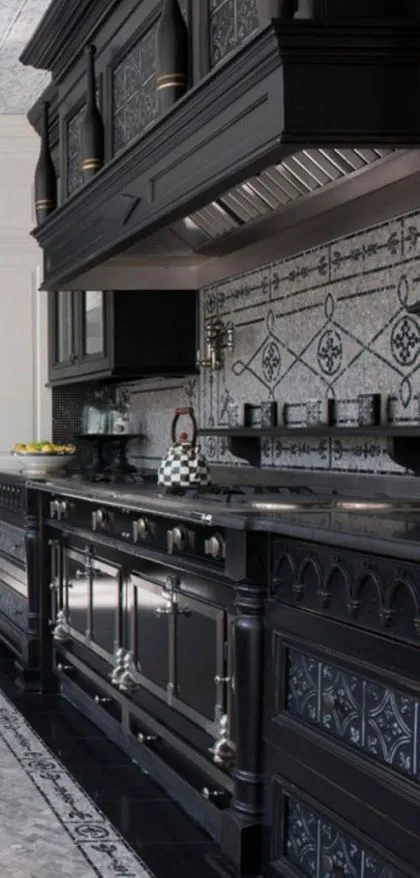The Allure of Gothic Kitchen Decor
Gothic kitchen decor offers a captivating blend of mystery, elegance, and dramatic flair, transforming the heart of your home into a sanctuary of dark beauty. Unlike the minimalist or brightly lit kitchens of modern design, a gothic kitchen embraces shadow, texture, and history. It’s a style that speaks to those who appreciate the unconventional, the romantic, and the timeless appeal of a bygone era. The richness of the design lies in its ability to evoke a sense of both comfort and intrigue, making the kitchen a place where culinary artistry meets a unique aesthetic. It is more than just decorating; it is about creating an environment that resonates with the soul, and celebrates the grandeur of architectural elements and a carefully curated collection of accessories.
Historical Roots and Inspiration
Understanding the origins of gothic design is essential to capturing its essence in your kitchen. This style emerged in Europe during the medieval period, characterized by soaring arches, intricate detailing, and a sense of verticality. Gothic architecture was primarily seen in grand cathedrals, castles, and other significant structures, embodying a sense of awe and spiritual grandeur. The core principles of Gothic design include an emphasis on vertical lines, the use of pointed arches and ribbed vaults, and a fascination with stained glass and intricate carvings. To translate this into a kitchen setting, it’s important to consider these architectural features and how they can be adapted for your own space. The history itself is filled with a sense of romance, mystery, and timeless beauty, providing a rich source of inspiration for creating a gothic kitchen.
Gothic Architecture Influence
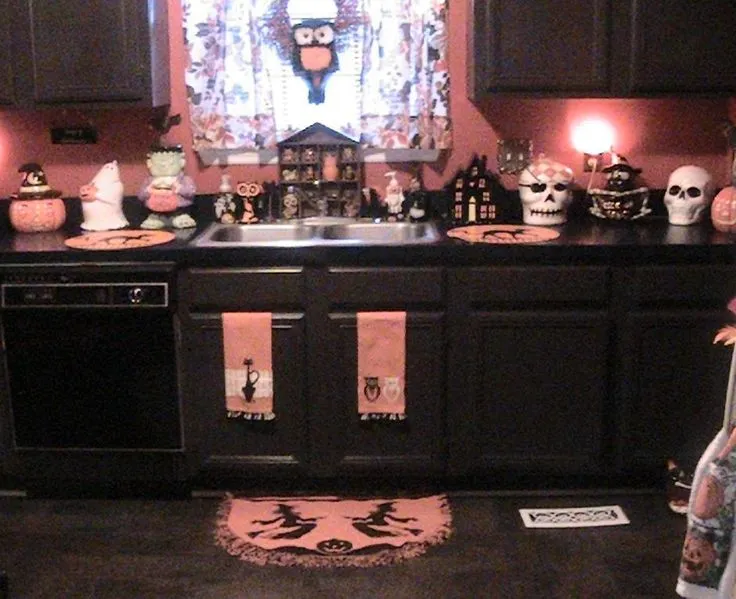
The architectural elements of Gothic design provide the foundation for this unique aesthetic. Key architectural aspects include the pointed arch, which adds height and visual interest, along with ribbed vaults which can be reflected in ceiling designs or cabinet detailing. These features create a sense of grandeur and verticality, giving the space a feeling of spaciousness. Consider the use of arched doorways or windows, or even replicate the shape using decorative moldings. Think about incorporating elements of tracery, the ornate stone or wooden framework, to cabinet doors or wall panels. These architectural choices will add texture and visual depth to the kitchen, making it a truly unique and immersive space. This will transform the kitchen into a visually stunning and historically resonant space, capturing the very essence of Gothic design.
Key Elements of Gothic Design
Gothic design emphasizes several key elements, including pointed arches, ribbed vaults, and intricate detailing. These elements are crucial to achieving a genuine gothic aesthetic. Dark, rich colors are also vital to the design, especially deep reds, purples, and blacks, which create a mysterious atmosphere. The materials often used include dark wood, stone, and wrought iron, which offer a touch of historical authenticity. The intricate details such as carvings, stained glass, and ornate hardware contribute to the overall visual appeal. Incorporate these elements through the selection of cabinetry, hardware, lighting fixtures, and accessories. This comprehensive approach will help you create an immersive Gothic kitchen design that is both elegant and evocative.
Color Palette Secrets for Gothic Kitchens
The color palette is a cornerstone of a gothic kitchen. The goal is to create a moody, atmospheric space, and the choice of colors plays a key role in achieving this. A balanced palette of dark hues is essential to bring the gothic aesthetic to life. It’s important to use these colors with care to avoid the space feeling too dark or closed off. The key is to create a harmonious blend of tones that establish a sense of both drama and sophistication, using colors that evoke the romance and allure of gothic style. The thoughtful use of color can dramatically alter the ambiance of your kitchen, transforming it into a dramatic, sophisticated space.
Embracing Dark Hues
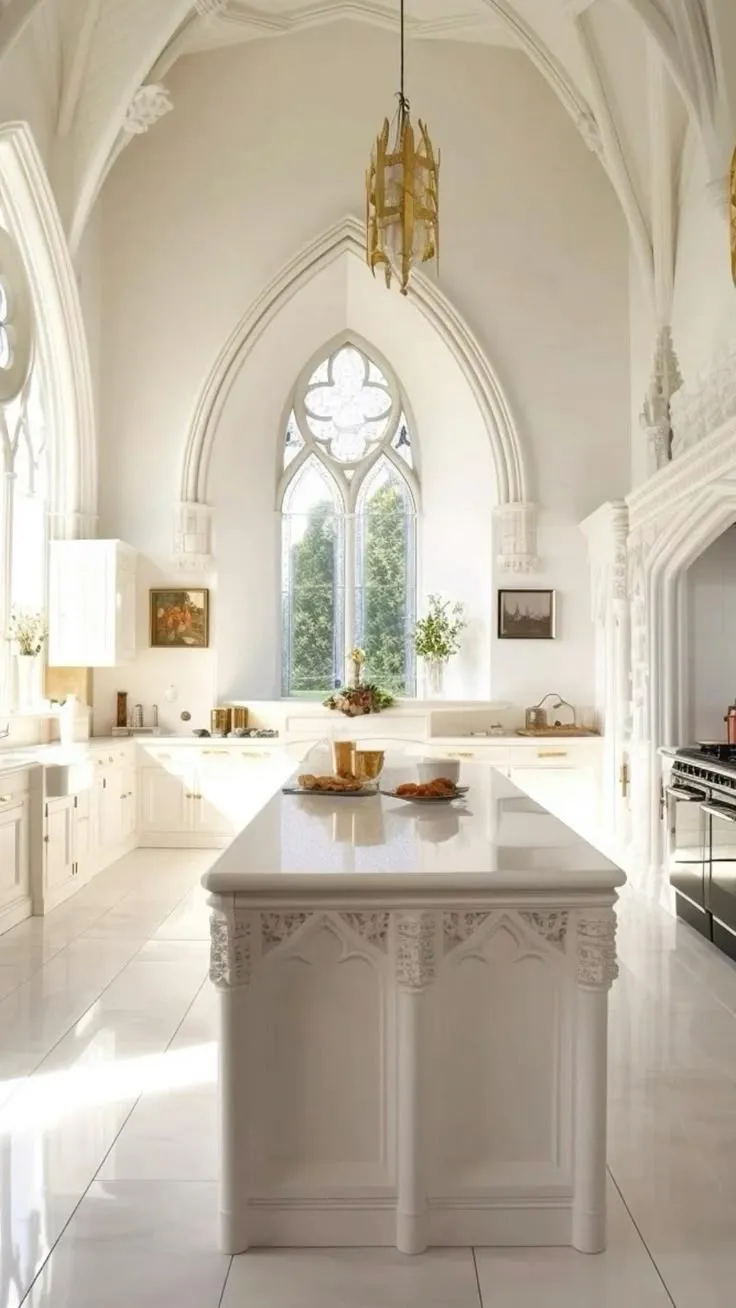
The foundation of a gothic kitchen is rooted in dark and rich colors. This includes deep shades like charcoal gray, black, and various shades of dark brown. These colors create a sense of mystery and sophistication. Use these shades on the cabinetry, walls, or even the kitchen island to create a dramatic focal point. The key is to balance these dark colors with lighter elements, such as metallic accents or lighter countertops. A dark base provides a wonderful foundation for adding contrast, allowing other design elements to pop. By embracing dark hues, you’ll create the perfect backdrop for other gothic elements, setting the stage for a truly immersive and atmospheric experience.
Incorporating Deep Reds and Purples
Deep reds and purples bring warmth and luxury to the gothic kitchen. Consider incorporating these colors through accent walls, decorative items, or even upholstered seating. Burgundy, crimson, and plum shades create a sense of opulence and drama. The use of these colors can be a great way to add a touch of personality. These colors are often found in the tapestries and rich fabrics used in medieval decor, providing a visual connection to the era. By carefully integrating these colors, you can create a cohesive and captivating gothic kitchen design. They add an element of richness and create a sense of depth, making your kitchen a true masterpiece of design.
Using Metallics and Accents
Metallics can add a layer of sophistication and contrast to the dark color palette. Gold, silver, and bronze accents can be used on cabinet hardware, lighting fixtures, and decorative items. Metallic details reflect light, adding brightness and preventing the space from feeling too heavy. A touch of metal also adds a layer of visual interest, breaking up the dark tones and enhancing the overall aesthetic. Use metallic accents to elevate your design. Incorporate metallic elements to create a sense of balance and enhance the gothic theme. By selecting metallic accents with care, you can transform your gothic kitchen into a stunning and luxurious space.
Furniture and Fixtures that Define Gothic Style
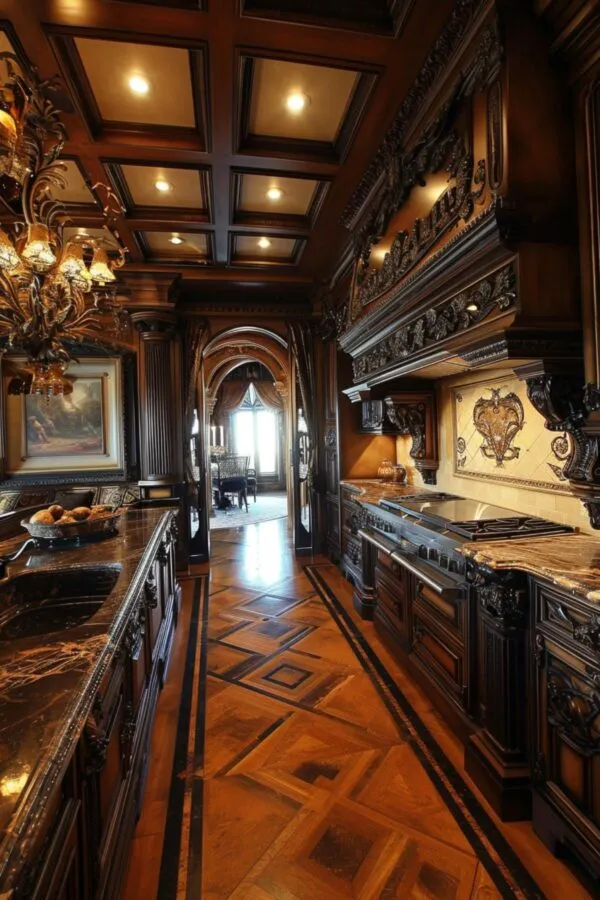
The choice of furniture and fixtures is vital to establishing a gothic atmosphere. The selection of these elements dictates the overall design and feel of the space. Choose items that embody the characteristics of the style, such as the use of dark woods, intricate details, and classic designs. This careful consideration will help to ensure that your kitchen reflects a true gothic aesthetic, making it a stunning space.
Choosing the Right Cabinetry
Cabinetry serves as the backbone of any kitchen, and is particularly vital for gothic design. Dark wood cabinets, such as those made from mahogany or walnut, are ideal, as they contribute to the overall ambiance of mystery and elegance. Choose cabinets with detailed carvings, arched panels, or ornate trim to amplify the gothic aesthetic. These features are reminiscent of the intricate detailing found in gothic architecture, providing an authentic visual connection to the historical style. Consider also the use of stained glass inserts or metal accents to enhance the gothic theme. The right cabinetry will provide both functionality and aesthetics, setting the tone for the rest of the design. It’s an investment that will dramatically shape the atmosphere of your space.
Selecting Gothic-Inspired Hardware
Hardware choices are a critical part of your gothic kitchen design. Opt for hardware in materials such as wrought iron, antique brass, or pewter. These materials will complement the dark tones and add to the overall gothic feel. Look for cabinet pulls and knobs with intricate designs, such as fleur-de-lis motifs or gothic arches. These details enhance the visual complexity. The choice of hardware can make a significant difference in the aesthetic appeal of the kitchen, providing the perfect finishing touch. By carefully selecting gothic-inspired hardware, you can transform your cabinetry and create a cohesive, visually striking space.
The Role of a Statement Island
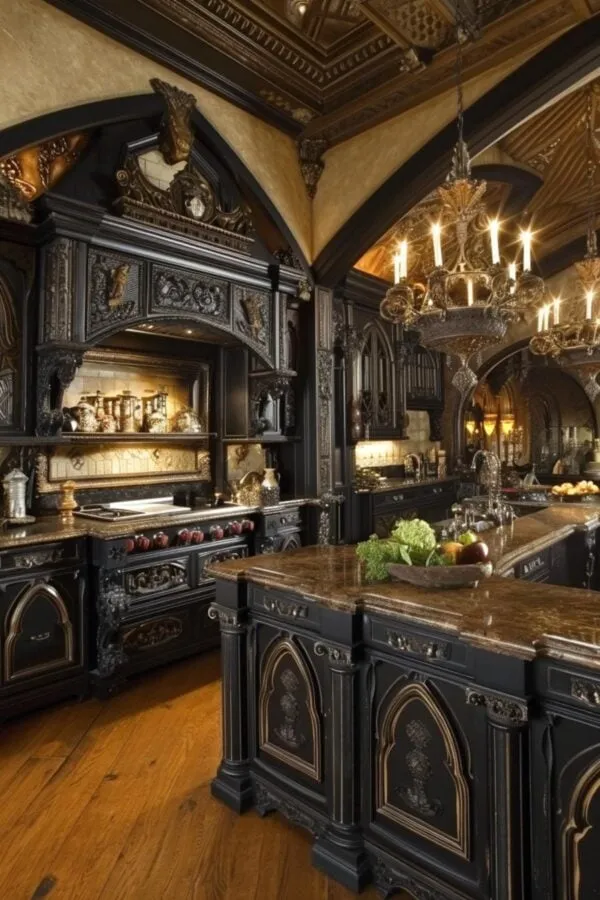
A statement kitchen island can become a focal point in your gothic kitchen. It provides both function and aesthetics. Opt for an island that echoes the themes of gothic design. Consider using dark, rich wood with intricate carvings or details. An island with a stone countertop can add a touch of rugged elegance. Add gothic elements such as ornate legs or a unique lighting fixture to make a bold statement. This statement piece can anchor the space. The kitchen island is an opportunity to make a dramatic statement and reinforce the gothic theme. It serves as both a functional workspace and a stunning design feature, essential for a cohesive and evocative kitchen.
Decor and Accessories to Elevate Gothic Kitchens
The correct accessories can complete the gothic transformation. The finishing touches can add character and cohesion, tying everything together. By thoughtfully curating accessories, you can enhance the mood and create an immersive gothic atmosphere. This approach will ensure a stunning and sophisticated space that is true to the essence of gothic design.
Adding Dramatic Lighting
Lighting is critical in a gothic kitchen, where shadows and ambiance play a significant role. Choose lighting fixtures that echo the style. Chandeliers with wrought iron details or antique-inspired pendants can provide soft, atmospheric lighting. Consider the use of sconces with ornate detailing. Add under-cabinet lighting to highlight architectural features and create depth. In addition, consider adding a dimmer switch to further control the atmosphere. These carefully chosen lighting elements will add depth and character to your kitchen. Proper lighting is crucial for creating a truly immersive and dramatic gothic space.
Incorporating Gothic Art and Mirrors
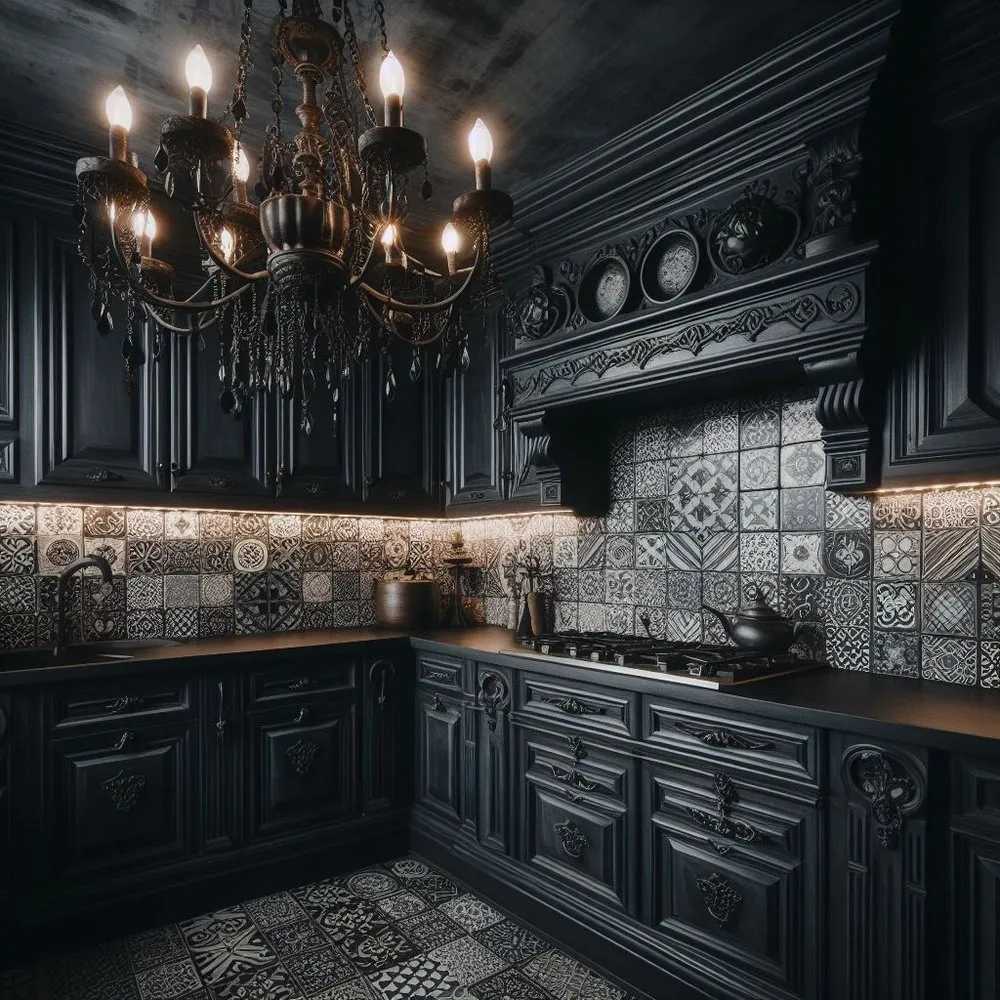
Gothic art and mirrors can dramatically enhance the aesthetic appeal. Select artwork with dark themes or medieval imagery, such as portraits or landscapes in ornate frames. Mirrors can add a sense of depth and reflect light, creating a more expansive feel. Choose mirrors with elaborate frames, such as those with arched tops or decorative carvings. These pieces serve both functional and aesthetic purposes. The inclusion of carefully selected art and mirrors will contribute to the gothic theme. These are key elements in developing a cohesive and immersive gothic kitchen design.
Textiles and Fabrics to Use
Textiles play a key role in establishing the mood. Include fabrics with rich textures and patterns such as velvet, brocade, and damask. These materials add warmth and elegance. Use these textiles on cushions, curtains, or even to cover bar stools. Consider patterns such as fleur-de-lis or medieval-inspired designs. The incorporation of these textiles will provide a cohesive feel. These touches add layers of visual interest and comfort to the space. The right fabrics can transform the kitchen into an immersive and inviting gothic sanctuary.
Bringing it All Together
The art of gothic design lies in the ability to combine all elements harmoniously. By taking the various pieces and blending them together, you can bring your vision to life. This includes the colors, furniture, fixtures, and accessories that define your kitchen. The cohesive design and the meticulous attention to detail creates a truly immersive experience. Ensure that your choices align with the gothic theme for a well-balanced and captivating result.
Tips for a Cohesive Design
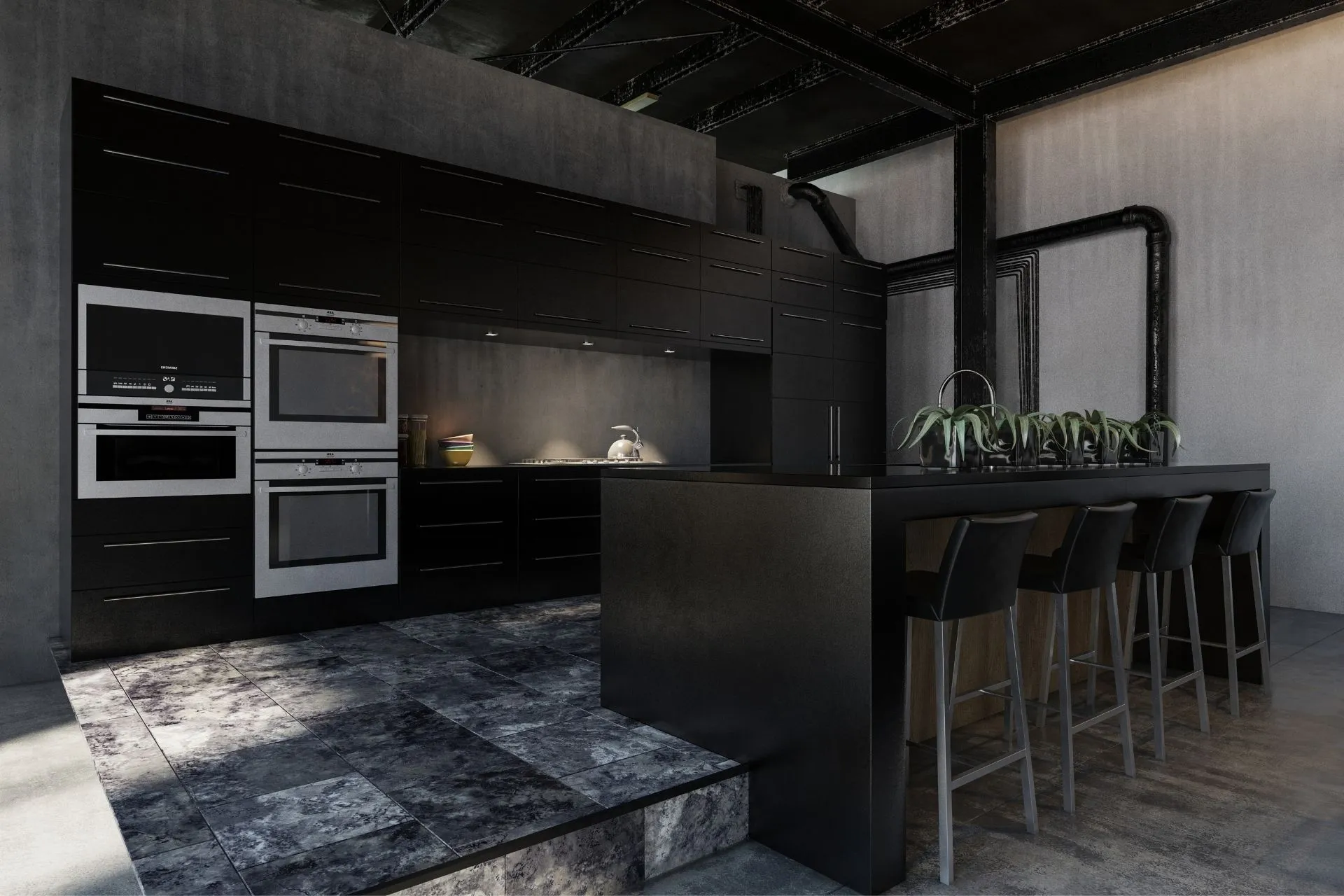
Achieving a cohesive design in your gothic kitchen means establishing a visual flow. Start by choosing a consistent color palette and stick to it throughout the space. Ensure that all elements, from cabinetry to accessories, have a unified look. Use repeating patterns, colors, or materials to reinforce the gothic theme. Select complementary materials and finishes. This is important in establishing a visual balance throughout the space. Consistency will prevent the kitchen from looking cluttered. The cohesive approach is essential for creating a well-designed space that evokes a sense of drama and elegance.
Avoiding Common Mistakes
Avoiding common pitfalls can ensure your gothic kitchen design achieves its full potential. One common mistake is overcrowding the space. Keep the space uncluttered and maintain a balance. Another mistake to avoid is using too many contrasting colors. A well-planned color scheme is key. Finally, avoid using cheap materials. The authenticity and elegance of gothic design rely on quality. By avoiding these pitfalls, you can create a stunning and authentic gothic kitchen design.
Maintaining the Gothic Aesthetic
Maintaining a gothic kitchen means preserving its unique charm. Regular cleaning and upkeep are essential for preserving the look of dark wood. The care of metallic accents and decorative items ensures their longevity. Update decor regularly to keep it fresh and stylish. A thoughtful approach will ensure that your kitchen maintains its gothic character. By taking these steps, you can continue to enjoy the unique beauty of your space for years to come. By preserving and enhancing the space, you can ensure that your gothic kitchen design continues to be a place of inspiration, elegance, and mystery.
